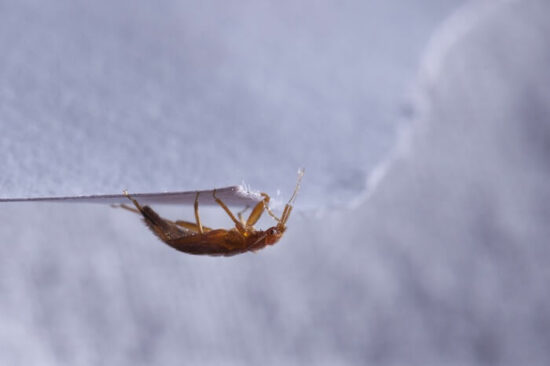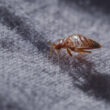Knowing the answer to the question, “How big are bed bugs?” is important if you want to be able to recognize them and determine if you have an infestation. While you can use other identifying factors like shape and color to pick them out, size is an important one you don’t want to miss.
This guide will cover everything you need to know about the typical bed bug size (at each stage of their life) and how you can use that information to keep your home free of these pests.
Table of contents
How Big Are Bed Bugs?
Bed bugs are on the smaller end of the size spectrum compared to other household pests. Their tiny size undoubtedly helps these pests remain unseen by most.
The average adult bed bug size is usually five to seven millimeters long. That’s about a quarter of an inch on the upper end of the scale. Many compare adult bugs to the size of an apple seed!
While a quarter of an inch is the norm, bed bugs can vary in size quite a bit. The insects go through several stages of growth after birth. Not only that, but bed bug size can change based on how recently they ate!
- Kill bed bugs and bed bug eggs
- Use spray as a spot treatment around bed frames, mattress seams/tufts/folds, and baseboards
- Kills even the toughest bed bugs
- The continuous spray Comfort Wand easily gets into hard-to-reach areas
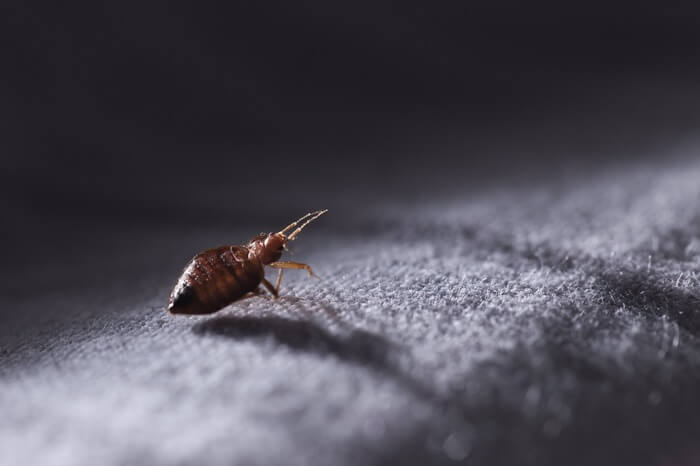
That means a more reliable way to identify the bed bug is to look closely at its physical features.
Upon closer inspection, you’ll notice that the insect has a long and flat build. The body features three segments. The biggest part of their body is the lower abdomen.
The abdomen is sporting some fine, gold-colored hairs. Completing the bug’s profile are six legs and two antennae.
Interestingly enough, bed bugs have wings, too. However, they are incapable of flight. These insects aren’t very fast on foot, either!
Quick Tip: Because they lack any effective modes of escape, the bed bug’s small size is crucial to their survival. At only a quarter of an inch at their largest, the pests are perfectly capable of sneaking around your home discreetly.
Bed Bug Size At Each Stage Of Their Life
As we hinted at earlier, bed bugs go through several stages during their life cycle.
Unlike many other insects you might find around your house, bed bugs do not rely on metamorphosis to grow. They don’t have a larval stage or pupate to develop wings. From the moment they hatch from their eggs, the insects have the same biological makeup.
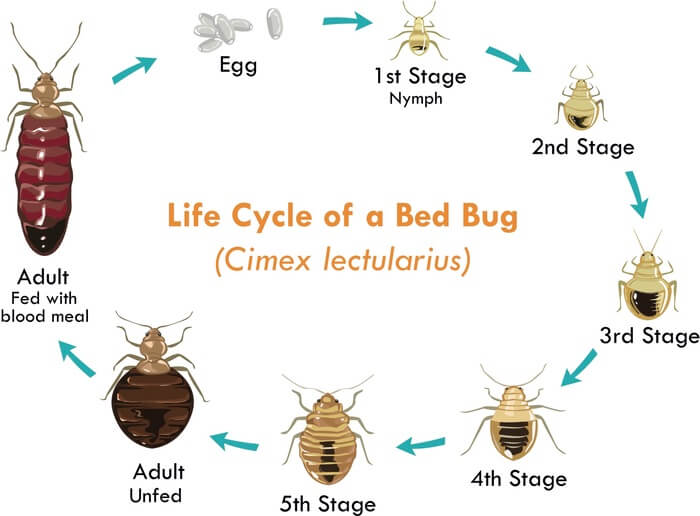
The only difference between these stages is how big they are!
Eggs
Let’s start with the egg stage.
Bed bug eggs are incredibly tiny, measuring only one millimeter long. For some reference, that’s about the size of a pinhead. They’re oval-shaped and take on a bright white color. Oftentimes, the eggs appear shiny due to the sticky surface.
While small, it’s not too tricky to see eggs with the naked eye if you know where to look. Adult bed bugs lay the eggs on wood and fabric surfaces. Thanks to the aforementioned sticky surface, you might see them on vertical surfaces as well.
Females can lay upwards of 500 eggs in their lifetime. That means it’s not uncommon to see large quantities of eggs in the same place.
Stage One
After a brief period of incubation, baby bed bugs emerge from their shell. Babies are also known as nymphs. They’re fully formed bed bugs, but there are a few physical differences between adults.
The most obvious is size! Freshly hatched bed bugs are a mere 1.5 millimeters in length! However, they grow pretty quickly after that.
Bed bugs move through five stages as they grow. Between each step, the insect will molt and leave behind a shed exoskeleton! Not only that, but their color will develop from translucent white to a signature reddish-brown.
Stage Two
During the second stage, these bugs are a little bigger. The average bed bug size at stage two is about two millimeters.
Quick Tip: At this point, they may start to exhibit some minor color changes. A small dot of brown in the center of the abdomen is standard. It comes after the bug digests its first several meals.
Stage Three
During the third stage, bed bugs are about 2.5 millimeters long. That’s almost a tenth of an inch. The brown spot becomes a little more prominent as well.
Stage Four
Bed bugs in the fourth stage are around three millimeters big. The abdomen usually has a more significant brown center, too. The rest of the body starts to darken a bit as the full pigmentation creeps in.
Stage Five
In the final stage, baby bed bugs are about 4.5 millimeters. Most of its body is brown or tan now. The signature flattened body becomes more apparent as the bug is on the brink of adulthood.
Adulthood
When a bed bug is mature, it reaches lengths of five to seven millimeters in size. The reddish-brown color may continue to darken a bit as the exoskeleton hardens.
From this point on, adult bed bugs do not shed. They keep the same exoskeleton until death, which usually occurs in about two to four months. However, some bugs can live up to 10 months in the right conditions (this is quite rare).
Are They Big Enough To See?
Many people believe that you can’t see bed bugs because of how small they are. However, that couldn’t be farther from the truth! It’s quite possible to see them with the naked eye.
You’ll have a better view with a magnifying glass, but it’s not necessary to spot these pests.
Some bed bugs are larger than others. But once they reach adulthood, the brown-colored insects are easier to spot.
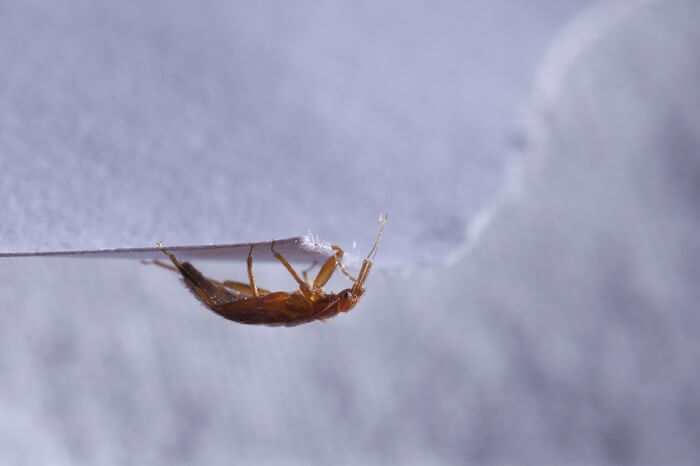
They can be more challenging to find as when they’re young. This is especially true with freshly-hatched babies. This is because they’re quite small and also a translucent white color (until they start digesting blood). That means they tend to blend in with white linens.
But make no mistake, finding bed bugs is not a walk in the park! This doesn’t have to do with their size as much as their behavior. Bed bugs are some of the most reclusive household pests. They’re masters at hiding. On top of that, they’re primarily nocturnal.
Quick Tip: Most bites occur when the bug is feeding at night. For this reason, they mostly go unnoticed until a large infestation invades a home.
How Their Size Changes After A Meal
When we talk about the average size of an adult bed bug, we’re referring to average unfed insects. If the pest recently ate, it can get even bigger!
- Kill bed bugs and bed bug eggs
- Use spray as a spot treatment around bed frames, mattress seams/tufts/folds, and baseboards
- Kills even the toughest bed bugs
- The continuous spray Comfort Wand easily gets into hard-to-reach areas
Bed bugs can hold about three times their body weight in blood. Where does all that blood go? It goes straight to their abdomen!
Usually, the abdomen is broad and flat. However, its segmented build allows it to expand like a balloon. The flat portion puffs out while the overall shape elongates.
It’s not uncommon for people to misidentify a freshly fed bed bug. The elongated shapes make them look more like a wasp or beetle than the traditional shape most are familiar with. So, how big can bed bugs get when they eat?
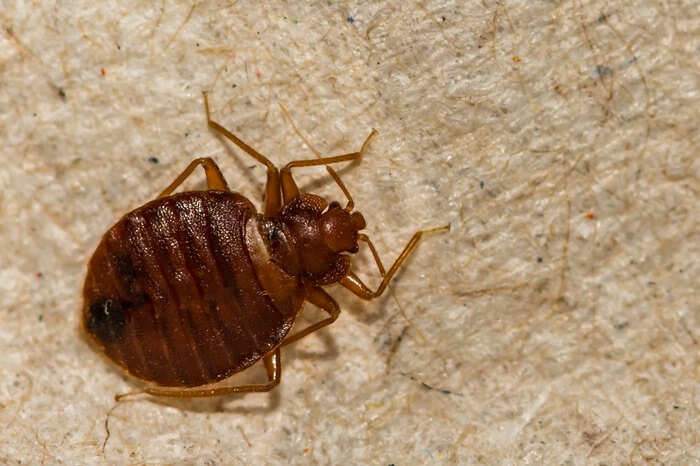
A filled-up bug can reach up to six and nine millimeters in size. That might not seem like a huge difference. But by comparison, it’s quite noticeable.
Bed bugs are opportunistic eaters. They don’t follow a predictable feeding pattern. Instead, they eat whenever food is readily available.
If they reside in your bedroom near your bed, most bugs will feed about once a week. These pests only feed for up to 10 minutes at a time. But in that short period, they can fill up and become satiated for several days.
Quick Tip: The bug will slowly deflate as they digest the blood in their system. By the time they return to normal size, these pests are ready to eat again.
How Big Are Nymphs?
Bed bug nymphs are small little critters that vary from around 1.5 millimeters to about 4.5 millimeters. However, they rapidly grow and move through five different developmental stages.
As we said earlier, these insects start as white and translucent. The more they feed on blood, the darker (and bigger) they get.
They’re also pretty vulnerable to damage. Their exoskeletons are quite thin compared to adults. Plus, they shed their skin as they get bigger. Don’t be surprised if you find tiny little bed bug shells near an infestation!
The Size Of Bed Bugs Compared To Other Pest Insects
Bed bugs are just one of many common household pests that can invade your home. These parasitic insects are some of the worst, and many homeowners squirm at the thought of having an infestation.
Of all the bugs you can have in your house, bed bugs are usually the ones that are misidentified the most. Before you see a similar-looking bug and start to panic, it’s important to understand how the size of bed bugs differs from other insects.
Fleas
Fleas are oval-shaped insects that like to feed on mammals. While they can bite humans, these bugs much prefer dogs and cats. Think of them as the animal counterpart to bed bugs!
In terms of size, fleas are more petite than bed bugs. Reaching lengths of 1.5 to three millimeters, they’re only a fraction of the size of bed bugs.
Not only that, but fleas are brown and don’t have that signature flat body. Fleas are also master escape artists that can jump to evade capture.
Ticks
Ticks are semi-similar to bed bugs in terms of both color, shape, and size. The common wood tick has the same reddish-brown color. It’s also oval and somewhat flat.
How do you tell the two apart?
Ticks live in the brush. You can usually find them near places where they can latch onto animals.
Another key difference is the legs. Ticks have eight legs. Meanwhile, bed bugs only have six.
Booklice
Booklice are another insect that the bed bug trumps when it comes to size. Adult booklice measure about 1.5 millimeters.
Despite the name, booklice aren’t actual lice. They don’t feed on animals or humans. Instead, they prefer to snack on fungi and mold!
Standard Lice
Now, typical head lice are pests you have to worry about. Known for spreading through children, lice like to invade the head and feed on human blood. They prefer to find hosts with thick and dirty hair.
Unlike bed bugs, lice feed around the clock. Furthermore, they lay eggs on the host instead of moving elsewhere to nest!
Lice are smaller than bed bugs. They’re actually closer in size to bed bug nymphs, measuring about 1.5 millimeters as adults.
Spider Beetles
While not true spiders, spider beetles sure do look it. They have long, slender legs. The bottom portion is pump and round, too.
Beyond spiders, these beetles are most commonly mistaken for bed bugs because of their similar color and shape. However, there’s a noticeable difference when it comes to size.
Spider beetles are only about 2.5 millimeters.
Swallow Bugs
Swallow bugs have the same oval abdomen and flattened body shape. They’re also pretty close in size to bed bugs. Adults are 4.5 millimeters long, which is about as big as a bed bug on the brink of adulthood.
Bat Bugs
Bat bugs are notorious bloodsuckers like bed bugs. Fortunately, they tend to leave humans alone in favor of bats instead.
These insects are just under six millimeters long, so pretty much as big as a bed bug. They’re also brown and segmented just like bed bugs. However, the abdomen has more of a defined point which makes it easy to tell them apart.
Roaches
Everyone knows what a cockroach looks like! Chances are, you’ll never mistake an adult roach for a bed bug. These pests can reach well over an inch in size. Some of the larger species get around 1.6 inches.
However, smaller species and babies are closer in size to bed bugs. German roaches, for example, are around four millimeters.
Quick Tip: It’s actually more common for people to mistake cockroach droppings for bed bugs, since they can be somewhat similar in size. But once you take a closer look, the difference should become clear. If not, it might be time for a trip to the optometrist.
Wrapping Up
Now that you’re an expert in bed bug sizes, it’s time for you to use this information to identify and get rid of these pests. Understanding how big they are will help you determine their age, which can be useful when dealing with an infestation.
Let us know if you have any other questions about how big bed bugs are, or if you’re having trouble identifying them. We’re always happy to help!
